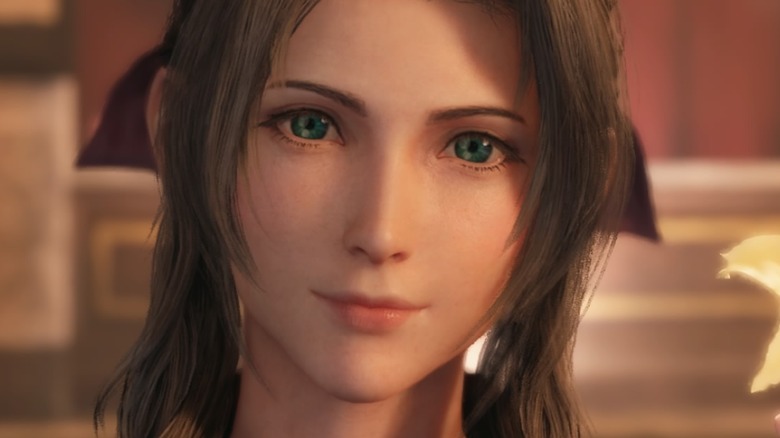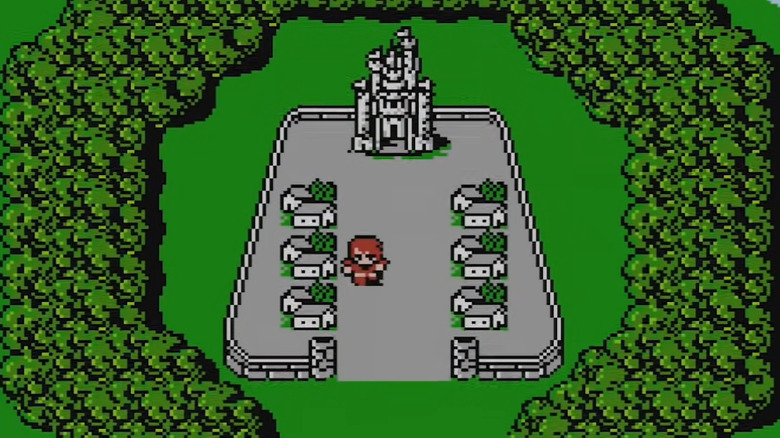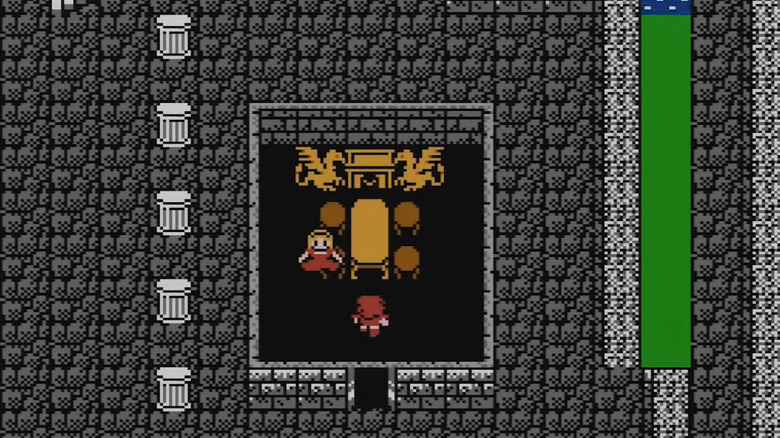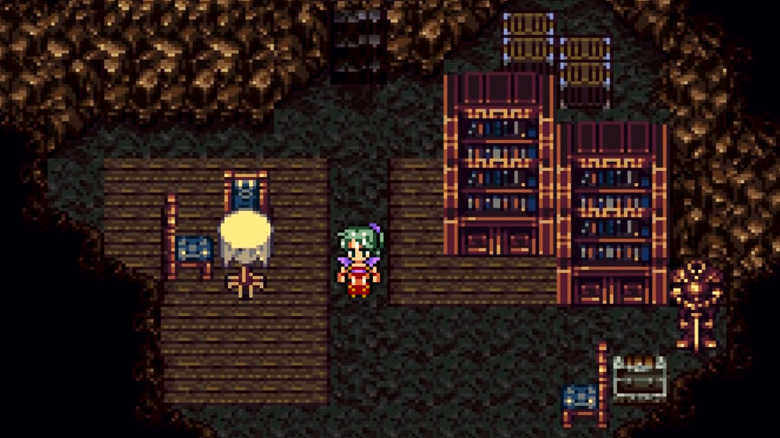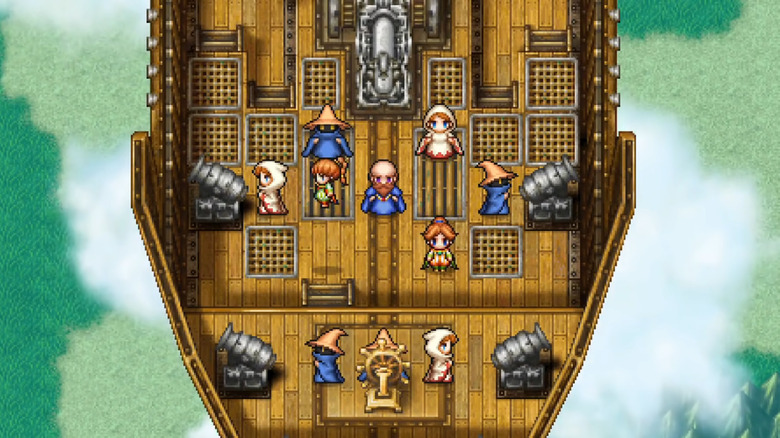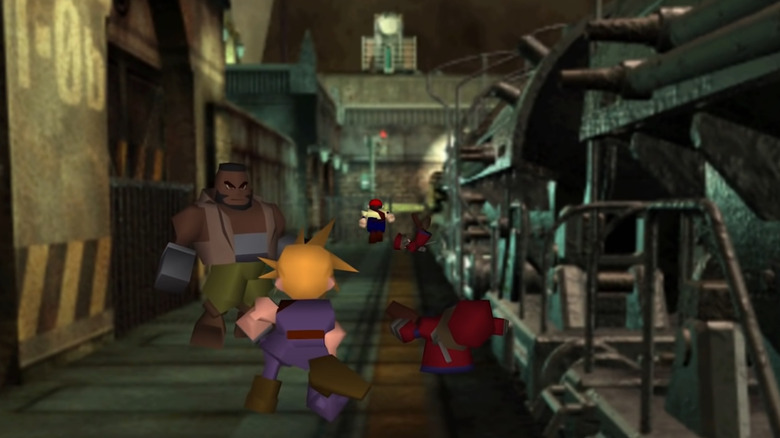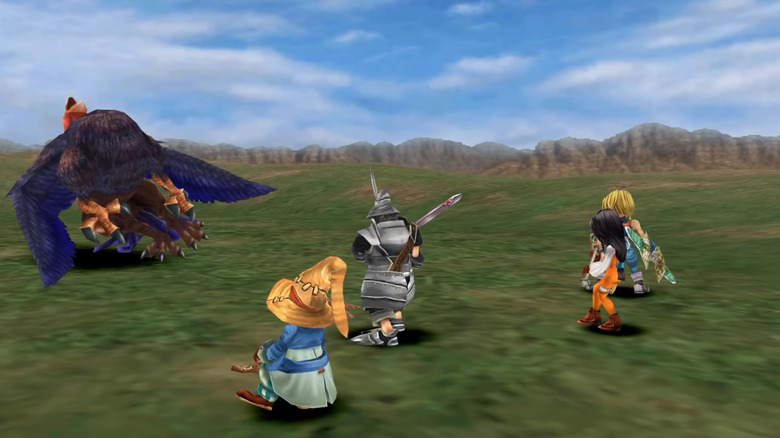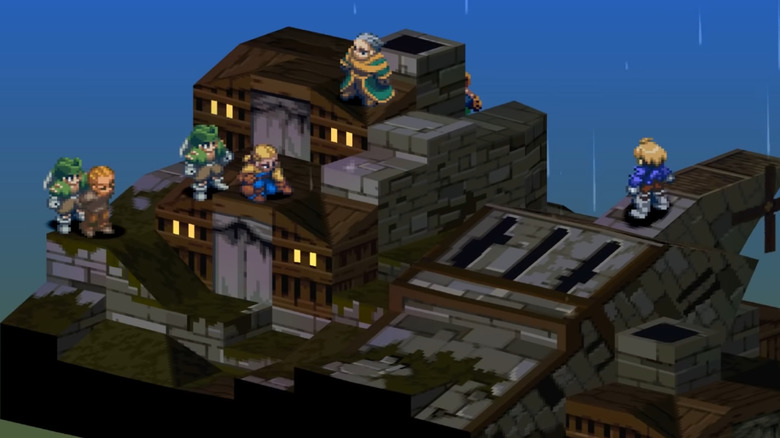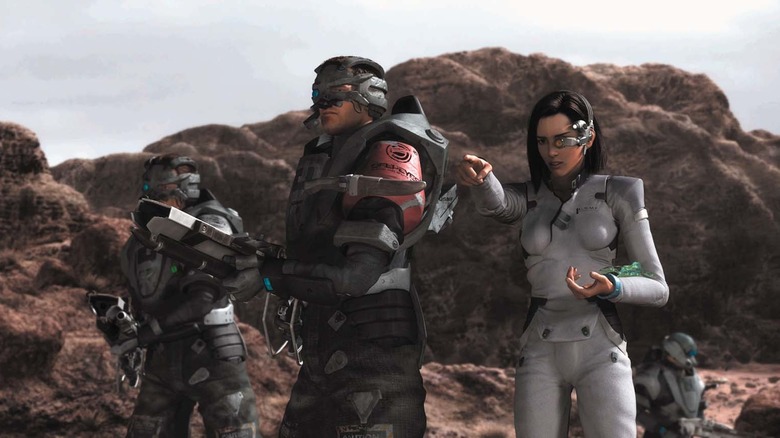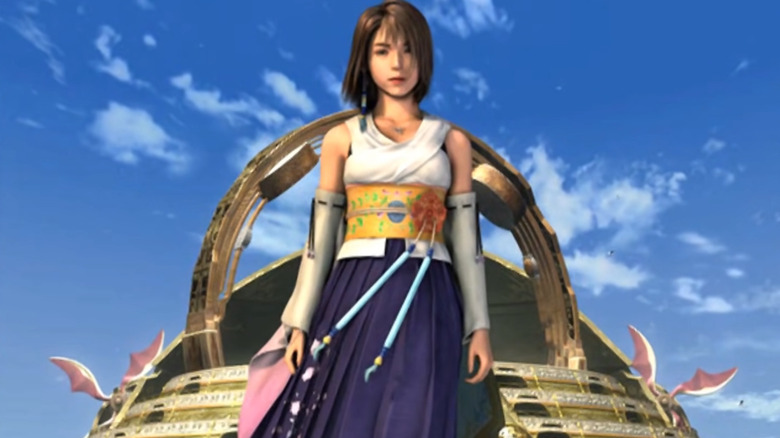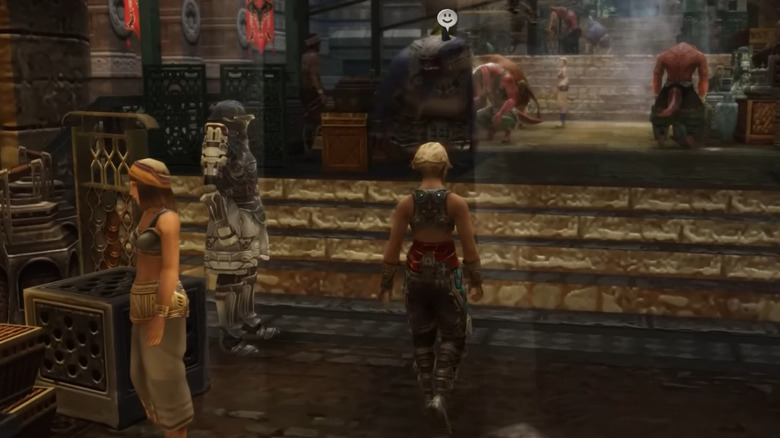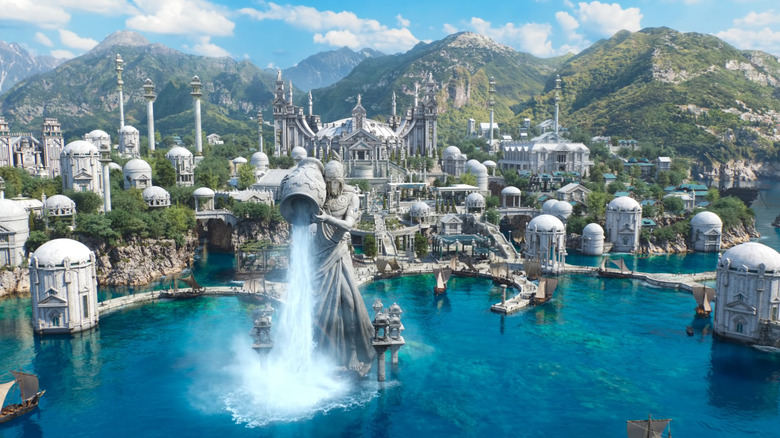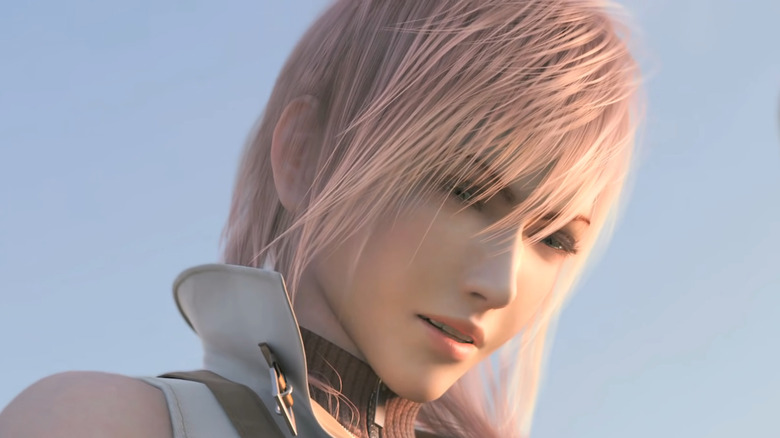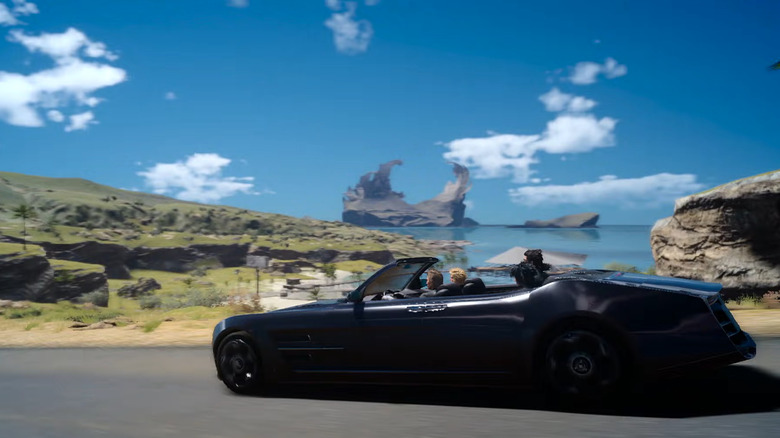The Stunning Transformation Of Final Fantasy
"Final Fantasy" is inarguably one of the most important franchises in gaming history. The Japanese role-playing series began in the 8-bit era, back when the Nintendo Entertainment System was considered to be cutting edge technology. Since 1987, "Final Fantasy" has produced fifteen mainline games and more spin-offs than anyone can track. Fans have stuck with the series through the highs of its greatest stories and the lows of its most impossible quests, and gaming as a whole is better for it.
Along the path of nearly three decades of success, "Final Fantasy" has revolutionized multiple gaming genres and breathed life into consoles like the SNES and the PlayStation. Few games have been able to sustain a successful existance across multiple consoles, genres, mediums, but "Final Fantasy" has continuously reinvented the wheel. The stunning transformation of "Final Fantasy," from struggling 8-bit hopeful to modern gaming behemoth, is a truly remarkable story.
Square in 1987
Considering that there are now fifteen games in the main series, the "Final" in "Final Fantasy" might ring hollow to some ears. Maybe that's why there's been a longstanding myth surrounding the name of the franchise that fans regularly circulate online. The story goes that Square, the studio behind "Final Fantasy," had been hit by tough times and believed that it was potentially about to go out of business. Creator Hironobu Sakaguchi believed that if Square went under, he would leave game development behind forever, and so he named his game "Final Fantasy."
Like every myth, there's a hint of truth in that story, but most of it is exaggerated. Sakaguchi himself told Kotaku, "Those days definitely seemed like end times, but honestly, any word that started with 'F' would've been fine." In reality, Square just wanted a game with a catchy name that could be abbreviated as "FF." Since "Fighting Fantasy" was already the name of a tabletop role-playing game, the most obvious choice was taken out of the running. Sakaguchi had to pivot, and so "Final Fantasy" was born.
The 8-bit era
The first three "Final Fantasy" games were released on the Famicom (recognizable as the Nintendo Entertainment System in North America). 1987's "Final Fantasy" was the only game in the initial trilogy to see a contemporary North American release. "Final Fantasy 2" debuted in 1988 but didn't leave Japan until 2002, when it was ported to the Playstation, and 1990's "Final Fantasy 3" only arrived in North America via the Nintendo DS in 2006 (per Hardcore Gamer). Release schedule aside, these three games set the baseline for the entire franchise, and their influence continues today.
"Final Fantasy" established the series as being narrative-driven with a deep turn-based combat system. Players controlled the Warriors of Light, a team of four unnamed heroes, each with a different class and set of abilities, who set out on a quest to save the world from Chaos. As Kotaku noted, the first game also featured a breathtaking array of unique sounds, many of which are still signatures of the series to this day.
"FF2" brought named playable characters to the series for the first time as it continued to push the envelope on video game storytelling. The game also introduced Cid, a character name that would appear in nearly every game since. "FF3" brought significant changes to character customization and combat, including a jobs system that allowed characters to take on new roles and abilities throughout the game. By 1990 "Final Fantasy" was beginning to come into itself.
The 16-bit era
After "Final Fantasy 3," the series left the Famicom behind and stepped into the 16-bit generation with the Super Nintendo for three more games. The fourth, fifth, and sixth installments in the franchise brought in a slew of new systems, characters, and stories, and they're still looked back on as some of the best games in all of "Final Fantasy."
If there's one installment that's emblematic of this era, it's "Final Fantasy 6." Over a decade later, Kotaku summed up the game and its legacy perfectly by calling it "simply the best." "FF6" delivered one of the most powerful stories in the franchise's history. The enthralling main plot is supported by an array of flashbacks and side stories, some of which are entirely optional, giving the game a depth that was unheard of at the time.
Story and characters are what people remember most, but gameplay is what keeps them engaged. As noted by Hardcore Gamer, "FF6" continued to utilize the Active Time Battle system that was first introduced in "Final Fantasy 4," and it allowed players, for the first time, to mix and match party members. Between its rich story and truly thrilling combat sequences in which players control multiple parties of characters, "Final Fantasy 6" is one of the few early "Final Fantasy" games that genuinely holds up to today's standards.
Getting Final Fantasy to the West
These days, "Final Fantasy" games are enjoyed simultaneously by fans all around the world. But back when the series first began, the process of selling a game outside of Japan was anything but straightforward. It took three years for the original "Final Fantasy" to get translated into English for sale in North America (per The Cutting Room Floor). By that point, Japanese fans were already onto the franchise's third installment, but incredible sales and overwhelming enthusiasm for "Final Fantasy" in North America convinced Square to pursue l for all their games.
As previously mentioned, it took well over a decade for "FF2" and "FF3" to reach North America, but that's actually because Square didn't want to leave its American fans too far behind their Japanese counterparts. When the company released "Final Fantasy 4," it moved to immediately translate the game into English and released it overseas as "Final Fantasy 2." Those early translations were riddled with odd choices and blatant errors that fans look back on fondly, but with a North American fan base locked down, Square began expanding its translation efforts. This process continued for decades, until "Final Fantasy 15" received a simultaneous worldwide release (per IGN).
The first mega hit
Released in January 1997, "Final Fantasy 7" became the biggest hit in Square's history, and marked a major turning point for the entire "Final Fantasy" franchise. It was the first game in the series that relied on 3D graphics, but at the time, that wasn't the most shocking fact about Square's latest game. What really shook the gaming world was the revelation that Square was abandoning its longstanding relationship with Nintendo to move over to the Sony PlayStation.
Two decades later, "Final Fantasy" creator Hironobu Sakaguchi insisted that the decision was spurred by the hardware limitations of the Nintendo 64. "PlayStation games being on CDs was the biggest factor," he told Polygon. Essentially, Nintendo 64 cartridges just couldn't deliver the 3D role-playing game that Sakaguchi envisioned.
The move seemed like a major risk, but "Final Fantasy 7" launched Square and its flagship series into the stratosphere. "FF7" is still the best-selling installment in the franchise, with more than 18 million copies sold. The game's world has been revisited in numerous spin-off titles, and "Final Fantasy 7 Remake" has brought Cloud, Sephiroth, and the world of Gaia to a new generation of gamers.
The end of an era?
Following "Final Fantasy 7," two more games rounded out this era of the franchise's history. "Final Fantasy 8" earned praise for its improvements to 3D graphics, character-driven storytelling, and attempts to change up the franchise's typical gameplay formula. Though it's undeniably a great game, it's unfortunately a middle child between two of the best "Final Fantasy" games of all time.
Speaking of which: It's almost redundant to call "Final Fantasy 9" the end of an era because the game makes such a conscious effort to call back to everything that came before it. After two games with stories that really blurred the line between fantasy and sci-fi, "FF9" returned to a more medieval-inspired setting, and its plot focused on a classical war between kingdoms.
While acting as a look back, the game's development process also foreshadowed Square's future. Square teams in Japan and Hawaii worked together to develop the game, making it the company's first truly multinational production (via RPG Site). It was also the final game in the series for two franchise veterans — composer Nobuo Uematsu and director, producer, and creator Hironobu Sakaguchi. Though it's never received any direct sequels, "FF9" has been a fan–favorite since its release, and its combination of nostalgia and progressive design make it just as good today as it was upon its release in 2000.
All of the spin offs
Between 1987 and 2000, Square made "Final Fantasy" a staple of the RPG genre and released nine games in the mainline series. What makes that accomplishment even more impressive is that the company also began a tradition of spin-off games that continues to this day. The spin-offs range from serious, story-driven companions to main titles – "Dirge of Cerberus: Final Fantasy 7," for example – to ridiculous experiences that almost feel like minigames (see: "Chocobo Racing").
It's usually easy to see these strange spin-off titles as simple cash-grabs, but Square put enough care into its work that some "Final Fantasy" spin-offs are looked back on more fondly than mainline entries. Games like "Final Fantasy Tactics," released in 1997, still earn heaps of praise for telling uniquely powerful stories and working to revolutionize niche gaming genres. "Crisis Core: Final Fantasy 7," released for the PSP in 2008, is getting its own remake on modern consoles. There have been dozens of "Final Fantasy" spin-off games, and there will likely be dozens more, all expanding the definition of what a "Final Fantasy" game is and enriching the franchise's deep and varied mythology.
Final Fantasy's biggest failure
Any series with more than 30 years of history and scores of different releases is going to have a few misfires. Not every mainline title has been revolutionary, but far and away the biggest failure of the "Final Fantasy" franchise arrived the first time the series made the jump to a new medium.
To be fair, 2001's "Final Fantasy: The Spirits Within," directed by Hironobu Sakaguchi and Motonori Sakakibara, is a stunning visual achievement. The animated feature film took a team of 200 people the equivalent of 120 years to make, and over the course of development Square stored 15 terabytes of 3D and 2D art (via Animation World Network). Even by today's standards, "The Spirits Within" looks fantastic. Unfortunately, that's about the only good thing that can be said about the film, which cost upwards of $130 million to make but only made back $85 million worldwide (via Box Office Mojo). That massive loss can mostly be attributed to a nearly incomprehensible story lacking any serious character development, which ultimately left critics and audiences disappointed.
The film was the last "Final Fantasy" project that series creator Sakaguchi worked on, but it wasn't the last time that "Final Fantasy" pointed itself at the big screen. The 2004 film "Advent Children" explored the world of "FF7" and fared slightly better critically, but the franchise's most recent film excursion, "Kingsglaive," performed much worse. "Final Fantasy" might be better off staying on gaming consoles.
Introducing Square Enix
Not long after the failure of "The Spirits Within," Hironobu Sakaguchi officially left his role at Square. It's easy to point to the movie's poor performance as the reason Sakaguchi left the company, but he says that the decision had much more to do with his desire to focus more on creating games than on the administrative tasks he needed to handle as Square's executive vice president. "I really loved Square, you know, and I was grateful for my position, but it just didn't feel like me," he told Polygon. Around that same time, Square delayed the release of "Final Fantasy 10," which was a first for the company.
Between the movie's failure and the next game's delay, Square found itself taking a financial loss for the first time in the company's history. In the midst of those hard times, Square shocked its fans and the gaming world by announcing a merger with its longtime competitor Enix in November 2002 (via IGN). Enix was the RPG powerhouse behind the "Dragon Quest" franchise, which predated "Final Fantasy." At a press conference, Wada Yuchi, president of Square and the new company Square Enix, said, ""The merger decision was made in order to further please game players, and in order to survive."
Once again, a new era for "Final Fantasy" and its publishers began.
A new era
Despite the aforementioned and unprecedented delay to "FF10," between 1999 and 2003 there was a new "Final Fantasy" game released once a year. "I truly am surprised that we finished developing a game in one year with a team of less than 100 people," said "Final Fantasy" producer Yoshinori Kitase in an interview with Game Informer. "FF10" was the first game in the series to come to PlayStation 2, as well as the first voice-acted installment in the franchise.
"FF10-2" became the first ever direct sequel to a "Final Fantasy" game. In years since, the sequel has been remembered even more fondly than the original by some fans. The two games not only set a precedent for "Final Fantasy" sequels, but also for remakes — a remastered collection of the two games was released in 2019.
"Final Fantasy 10" and its sequel were the last games developed by Square before the merger with Enix. By the time that "Final Fantasy 10-2" made its way to North America in November 2003, it was published under the new banner of Square Enix, kicking off the next era of "Final Fantasy" with a bang.
Breaking new ground with MMOs
"Final Fantasy" has always been a series that's willing to explore new gaming genres, though for over a decade it kept most of those explorations limited to spin-off titles. But in 2002, the series released "Final Fantasy 11," its first MMO. The game debuted to strong reviews, but it came just a hair too early to capture the MMO zeitgeist.
Though it didn't become the next "FF7" in terms of sales, the franchise's foray into MMO gaming was successful enough that in 2010 Square Enix released another MMO, "Final Fantasy 14." It was lambasted for being a poorly functioning mess of a game. Months after the game's release, Square Enix hired Naoki Yoshida as its new producer and director and gave him the task of saving the game (via Time). It was a seemingly impossible task, and no one could have faulted Yoshida for failing.
In the end, Yoshida didn't just make minor improvements to the game, he transformed the experience and turned it into one of the greatest MMO success stories of all time. At the end of 2021, more than a decade after the game's initial release, there were so many players clamoring for "FF14" that the games servers could barely support them all (via PC Gamer). The game stands as a testament to why "Final Fantasy" is such a powerhouse of a franchise, and it even managed to pull in series creator Hironobu Sakaguchi for hundreds of hours.
The troubled history of Fabula Nova Crystallis
Crystals have been a recurring, if not exactly defining, element in most mainline "Final Fantasy" games. Back in 2006, Square Enix announced a trio of games that would represent the "Fabula Nova Crystallis" arc, a reimagining of the role of crystals in "Final Fantasy" written by Kazushige Nojima, who'd been writing for the series since "FF7" (via RPG Site). More than a decade later, the story is finished, and though it provided some fun games, it never quite lived up to expectations.
The arc began with "Final Fantasy 13," arguably one of the most recognizable mainline entries in the franchise. The game had a rocky start – one reviewer called it the "biggest swindle in gaming history" – but its cast of characters, including protagonist Lightning, found enough fans that Square Enix decided to pursue two follow-ups.
"Final Fantasy Type-0" served as the second entry in the Fabula Nova Crystallis saga. The game is an action-oriented spin-off title that debuted on the PSP to strong reviews and has since been ported to the PlayStation 4 and the PS Vita. The final section of this long arc never exactly saw the light of day. What happened to "Final Fantasy Versus 13" is a complicated story that has just as much to do with poor marketing as it does mismanaged game development. Ultimately, what Square Enix meant as a game set in a modernized world was scrapped, reinvented, and rebranded as "Final Fantasy 15."
Final Fantasy 15 and beyond
The ending of "Final Fantasy 15" marks the end of another era. "Fabula Nova Crystallis" didn't pan out as Square Enix initially planned, but without the company's waywad attempts at a trilogy composed of one mainline title and two spin-offs, "FF15" wouldn't exist. The game essentially rose from the ashes of "Final Fantasy Versus 13" and delivered arguably the best mainline "Final Fantasy" experience since "FF10."
"FF15" debuted to positive reviews, though there were complaints made about the game's simple combat system and underwhelming story. Some of those complaints can be chalked up to Square Enix's narrative strategy for the game, which included tie-in mobile games, an anime, a feature-length movie, and a plethora of DLC (via Destructoid). Complaints aside, "Final Fantasy 15" offered stunning graphics, fully realized characters, and a gorgeous open world to explore, which is why some have argued that it's been incredibly underrated. The game served as a strong pivot away from the Fabula Nova Crystallis saga, proved that "Final Fantasy" still has a place in modern gaming, and laid the groundwork for Square Enix to embark on another epic new era with "Final Fantasy 16," an M-rated game that represents another evolution for the series.

